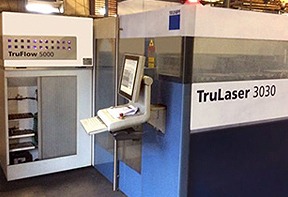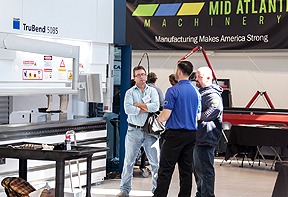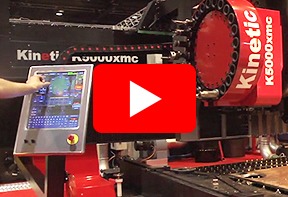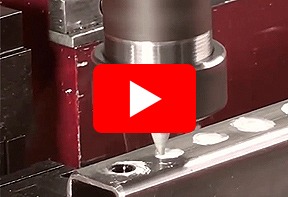CO2 vs Fiber Laser Cutting – Pros and Cons
A Burning Question
Fiber laser cutting or CO2 laser cutting: Which is better for cutting metal?
This question has sparked years of conversation and discussion among manufacturing experts. Some insist CO2 is the better technology, while others would never go back to CO2 after experiencing the innovations of fiber laser cutters.
Is there a definite right answer? Most laser manufacturers offer both CO2 and fiber laser cutting systems, but in recent years fiber laser cutting has really made a name for itself. The truth is customers must carefully analyze their operational capabilities, power sources, performance requirements, and material types and thickness before investing in the laser cutting system that works best for them.
What is Fiber Laser Cutting?
Fiber laser cutting, or solid-state laser technology, is newer to manufacturing and metalworking, making its debut only about 15 years ago. CO2 laser cutters have been around for almost a half-century, but fiber laser technology burst onto the scene and impacted the entire sheet metal fabrication industry with its prodigious power and speed.
In just five years, fiber lasers had already achieved the 4kW cutting threshold that took CO2 lasers about two decades to reach. Today, fiber lasers have achieved up to 12kW and beyond. Contrary to popular belief, speed isn’t everything, but it is a testament to how far laser cutting technology has evolved.
A fiber laser cutter delivers an extremely intense, amplified beam to the cutting head of the laser machine. The beam is readily absorbed into the material and not reflected. The fiber receives the light source from the resonator of the laser cutting machine and brings it to the CNC-controlled cutting head.
Fiber lasers can cut metal that is more than one inch thick, but optimal performance comes on cutting metal that is 1/2 inch thick or less. For processing stainless steel, aluminum, brass or copper, fiber laser cutters are becoming known as the fastest and most economical option.
Fiber laser cutters work when nitrogen or oxygen is employed as an assist gas. Nitrogen can expel molten material as fast as it is melted. Using oxygen as an assist gas creates a wider channel to expel the molten steel. The wider beam profile also produces faster cutting speeds and increased cut edge quality on thicker materials.
So what are the advantages? Fiber laser cutters have a long list:
- Less power to operate. Usually one-third to one-half of what a CO2 laser system would need.
- Faster cutting speeds. A high-powered fiber laser cutter can cut up to five times faster than a conventional CO2 laser. For example, a 4KW CO2 in 16 GA Mild Steel using N2 as a cutting gas has a recommended cutting speed of 260 IPM; an equally equipped fiber laser has a cutting speed of about 1,417 IPM – quite a difference.
- Easier to maintain. Fiber laser cutters have no mirrors, lenses, or bellows to clean and replace.
- Initial Costs: As this laser technology becomes more common; costs are decreasing throughout the industry.
Taken all together – greater throughput, lower operational costs, and less maintenance – these advantages can mean greater productivity, lower cost per part, higher potential profit margins, and shorter return on investment time.
What is CO2 Laser Cutting?
On a CO2 laser cutter, light is produced when electricity flows through a gas-filled tube with mirrors at both ends. One mirror is fully reflective while the other one lets some light come through. These mirrors guide the laser beam into the material to be cut. The gas is carbon dioxide as the name suggests.
CO2 laser cutters can cut all types and thicknesses of steel and metal: Mild steel, stainless steel, aluminum, as well as plastic, tile, marble, and stone.
CO2 laser cutters offer several advantages:
- CO2 laser cutters have more flexibility to cut through a wider range of materials, including non-metals.
- Thicker materials: For thicker materials over 5mm, CO2 laser cutters can deliver faster initial piercing times, quicker straight-line cutting, and smoother surface finishes.
- Edge quality: The finishes obtained in CO2 laser cutters will be beaten every time when compared to fiber laser.
- Reliability: CO2 laser cutters have been around for more than three decades, and many in the industry are familiar with their functions.
The downside is CO2 lasers cost more to operate and maintain. Aside from the consumables, and gasses required to keep the beam path delivery system functioning optimally, power costs can be up to 70% higher.
The Bottom Line
Each laser cutting system has its strengths and weaknesses, as well as compelling arguments for specific uses when cutting various metals like aluminum, stainless steel, and steel.
Which laser cutter is right for you comes down to usage. Which systems best fit your operation and application? How much faster and how much more cost-effective are your parts going to be produced? The answer comes only after a careful analysis of operation costs, throughput, maintenance expenses, and costs.
Your Laser Cutting Partner
No matter what laser cutting system you decide to use, Mid Atlantic Machinery supplies high-quality, high-performing Trumpf fiber laser cutters and CO2 laser cutters to cut whatever metal you utilize and create the precision parts that satisfy your customers’ needs.
The fiber laser cutting and CO2 laser cutting systems we offer provide the innovative features you expect from an industry-leading manufacturer of metal fabricating equipment:
- Available in a variety of sizes and speeds
- Have expansive capabilities complete with automation options
- More accuracy, better parts, and faster throughput
- Help reduce waste
- Maximize productivity and profitability
Mid Atlantic Machinery has served fabricators, manufacturers, and related businesses with the latest in fabrication and machine tool technology for more than a quarter of a century. We represent top equipment brands throughout the Mid Atlantic region and New England. From Maryland to Maine, we’re a one-call resource for the latest fabrication technology. Fill out a Contact form to get in touch today!









